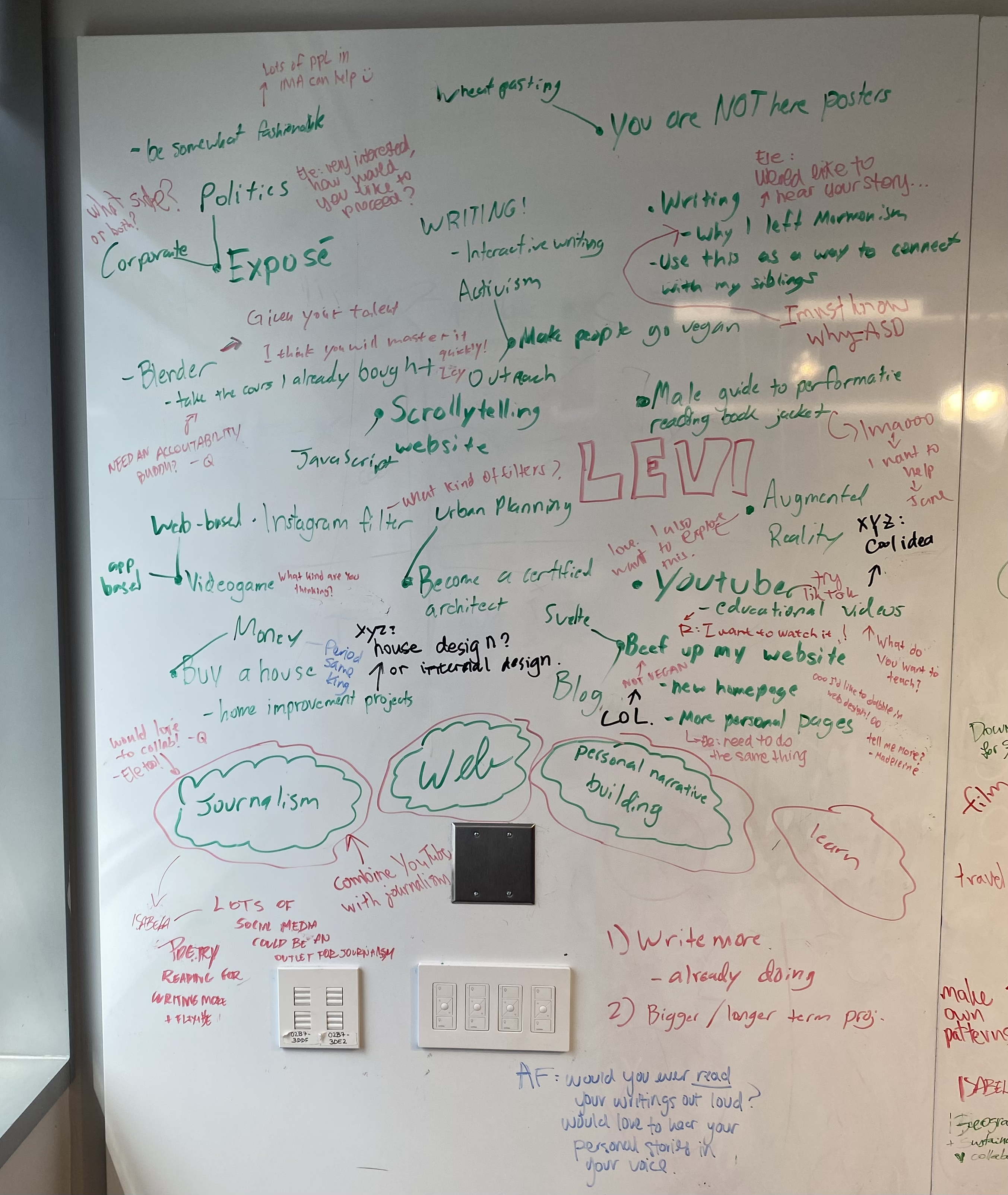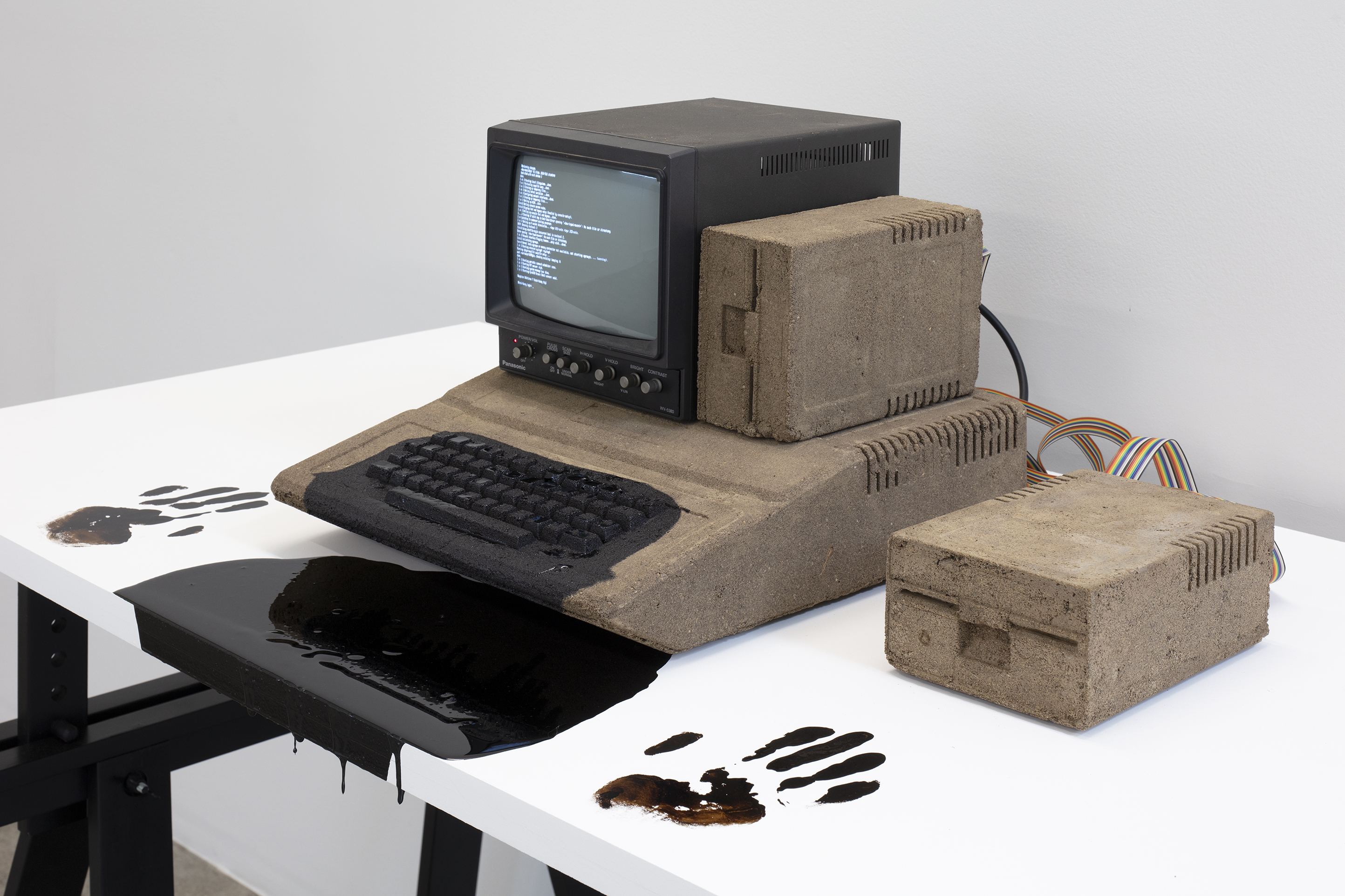Curiousity Syllabus
I’m halfway through my summer class Exploratory Making!
We started the semester by rapid prototyping projects, and following a prescribed set of readings, projects, and classroom discussions. However, we seem to be at a bit of an inflection point. This past class we spent most of the 2.5 hours thinking through and discussing what kinds of art, projects, and skills we were interested in developing. We mapped out these interests, and then tried to connect the commanalities, and invite our classmates to make connections that maybe we couldn’t.

My whiteboard after this class activty
I found this excersise too nebulous. We spent the first week of grad school really interrogating the reasons that we chose to come to this program, and what we want out of it. Since I have been working for the past four years, I have had ample time to think through what I want out of school, and the types of projects I want to complete in the next year of the program. Most of the work and learnings I have done in the past 4 years is self-taught and self-directed.
Because of this, an exercise that seems to be even more about self-study is unhelpful to me, someone who already has problems biting off more they can chew and chasing whatever whims catch my eye. Maybe I’m a bit too cynical but given the absurdly short amount of time we have in person, it seems like a cop-out to have a self-directed curiousity syllabus rather than a curated, instructor led program.
Indeed, a common theme in our media arts studies is the idea that we are living through a time of information overload. Much like how food scarcity was once a problem that has now led to widespread obesity and diabetes. Now our societies have become oversatuated with empty-calorie, hedonistic, capitalist controlled media diets. Part of my motivation for joining IMA low-res at NYU was to have curated syllabuses by thoughtful professors and academics with more knowledge and experience than me.
So color me skeptical at the idea of a ‘Curiousity Syllabus’ as part of this program.
But begrudgingly- I put together a maintainable version of this whiteboard on FigJam. I have another version of this that has lived in my iPhone notes app for a long time, which I add too anytime a new project idea comes to me. In fact - I have actually ticked three of those projects off my ever growing list for the first time in years!
Expanding my web of curiousity
To further push what we might be interested in exploring - we were directed towards three sources of further readings to find work that resonated with us.
- Artist profiles on Rhizome - A series of interviews and posts featuring contemporary artists who are creatively integrating technology and making
- Recess Art’s Session Residency Archive - Highlights the work of contemporary, emerging artists who were granted the Recess Art Session Residency, a residency that grants artists the opportunity to create process-based, interactive work in Brooklyn, NY
- The Agency of Unrealized Projects - A project created by e-flux, thinking about the vast number of art proposals, projects, and more that are rejected, but still should have a space to be honored!
This part of the assignment, like much of the program so far - is like drinking water from a firehose. There’s so much to see, read and experience in these links, and I clicked around until I felt like my eyes were at capacity for the night. That being said, there were two projects that really got me thinking
Artist Profile: American Artist
American Artist (Yes that’s their legal name), is a New York based multimedia artists. Their work Mother of All Demos II shown below really spoke to me, and I took some time to engage with why. I have often been drawn to representations of computers and technology that are out of the norm. Knitted QR codes, Minecraft redstone computers, etc. I think much of it is because it is very easy for me to lose site of the magic and the wonder of computers and the social internet. Growing up with limited computer access (both my parents and by our family computers ancient hardware), there wasn’t much that I took for granted.

American Artist, Mother of All Demos II, 2021. Dirt, monochrome CRT monitor, computer parts, Linux operating system, wood, asphalt. Courtesy of Labor, Mexico City.
But as I use some form of a computer seemingly nearly 24 hours a day - the computer and all it’s wonder fade into noises. Work such as this that brings the computer back to the spot in my mind it used to occupy, really stands out to me. Here, the artist constructs a vintage computer using widly inappropriate materials: dirt, ashpalt, wood. It brings this factory-constructed futuristic object back to the dirt of the earth, and reminds me of the rocks and sediments that are secretly behind the processing and brains of every computer. After all, computers are really just rocks we tricked into thinking.
Electronic Cafe for Poetic Computation

The Electronic Cafe for Poetic Computation (ECPC, pronounced easy-peasy)
The School for Poetic Computation is an independent, experimental school in Brooklyn that I applied to last year but never ended up attending. They host some seriously cool classes, and an even cooler group of people. In addition, they host an electronic cafe, a new take on internet cafes as they existed decades ago.
This work spoke to me because I am by and large a product of the internet utopian vision promised to us in decades past. I was swept away as a kid by the techno-optimism that flourished on the early-ish internet of the 2000s. The connection of anyone and everyone online, any piece of media, art and education at your fingertips. Soon the days of discrimation and inequality would be behind us as the internet empowered anyone on Earth to learn about the world and their fellow humans.
And in many ways, this optimism came to pass in my life. The internet was my first exposure diverse viewpoints and ideologies, and helped me empathize with people I might have never met in real life. I leveraged the internet to make friends, discover media I love, and most of all, to learn. I taught myself how to code, and used my skills to secure employment, apply to college, and eventually end up here.
But I have to recouncile the fact that for all the good the internet has enabled in my life, it has also wrought a host of unintended consequences for people around the world. This project made me think about all the good that has come from the “golden era” of the internet, and all the ways we have fallen short. And despite all the webs shortcomings, I still believe it to be a radical change-making medium, and I want to do my part to bring it closer to the best version of itself.
Reflection
In looking through these three large large bodies of work, I thought more deeply about why I liked and disliked certain pieces of art. One of the clearest thoughts that came from this exercise was that I really don’t like jumbled, overstimulating collaged media art. I experience so much of life in New York, and online as an overstimulating out of focus sensory overload. I don’t want that in the art I consume or create. I like to take simpler, clear ideas and take them as far as they can be stretched.
I don’t really want to use my curiousity syllabus over time. I feel like I have a clear picture of the things I want to make and explore. I have never been one to keep up a Pinterest board or 5-step plan, and I don’t envision it helping me now.